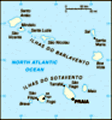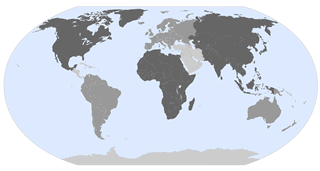Advertisement
Published: March 3rd 2016
Friday 19th February, 2016. Praia Santiago, Cape Verde Islands
We returned once more to this island nation, but this time to the island of Santiagu (Santiago) which is located between the islands of Maio (40 km west) and Fogo (50 km east) in the Sotavento Islands Group. Santiago was the first of the islands to be settled, the town of Cidade Velhabeing founded in Riberia Grande in 1462.
Praia lies on the southern coast of Santiago and is home to the island's ferry port and one of the nations four international airports. It is the capital and largest city of Cape Verde. It is a commercial centre and a port that ships coffee, sugar cane and tropical fruits. It has a thriving fishing industry and lots of resort beaches nearby which make it a popular tourist destination. Praia has a mild climate with a short wet season and long dry season. There is very little precipitation and the city only sees approxmately 260 milimetres (10 inches) of rain per year. Temperaturs are warm with an average high of 27 degrees C (81 degrees F) and an average low of 23 degrees C (73 degrees F).
The town of Praia da Santa Maria first appeared in 1615 and is one of the oldest administrative divisions in Cape Verde. It was originally favoured because of the nearby port on Santa Maria beach which offered good conditions for ships. The port was initially used as a clandestine harbour and th settlement gradually acquired the characteristics of a town after much of the population fled there during its decline in the freequent pirate attacks. The transfer of capital status from Ribeira Grande to Praia took place in 1770.
In Cape Verde's history there have been various successive proposals for transferring the capital elsewhere. The most recent was Mindelo in the late 19th century. In 1858 there was an offical decree when Praia's status changed from town to city. Praia secured its status as the captal of Cape Verde, concentratng on political, religious, and economic roles as a city.
As the boat was tying up M called her friend Eva who instructed us to take a taxi to Palmarejo and then to the "violet house next to Publico". We somehow managed to get on the first shuttle to the city centre
where we found a friendly taxi driver who didn't seem to get where we wanted to go and wanted to charge us 10 euros. M called Eva again and she spoke to the taxi driver. He took us for 5 euros and Eva was waiting outside for us to arrive. We were introduced to Frank, Eva's partner, who had just come back from getting some tarts etc for breakfast. The four of us ate traditional Portuguese custard tarts sprinkled with cinnamon and then M used Frank's Wi-Fi to post some blogs. Frank works at the University here and Eva is going to start working there too soon. Their house was very bare as there was not much furniture yet. In fact we probably drove past it in one of the containers on the dockside.
After M had finished on the internet, Frank ordered a taxi and we set off for Cidade Velha. This town was once the capital and is the oldest settlement in the Cape Verde islands. On the way into the town we passed the Real de São Filipe Fort which was constructed in 1590 to defend the Portuguese colony frm pirates, the French and
the English. It served for military purposes during the colonial days. We didn't have time to go inside. The taxi dropped us off at the ruins of the old cathedral.
This was the first cathedral built in West Africa, on the initiative of Friar Fraancisco da Cruz, the third Bishop of Cape Verde. Its construction started in 1556 in a prominent spot overlooking the ocean, but was not completed unti 1700 due to crises in the clercal institution as well as difficulties with the church's relations with royal authorities. The cathedral is characteristic of the late renaissance and is made up of a nave and a double transept. The crossing of the trancept marks the separation between the nave and the choral area, which is narrower. The sanctuary and the two bell towers that once framed the main door are no longer visible, but the huge lateral walls that remain providede an idea of the scale of the project. Stones brought froom Portugal were used in its construction. The cathedral was the object of some critisism for being considered too ambitious and for being located outside, albeit not far from, the city centre. Two years after its
edification the great Portuguese orator, Father António Vieira, preached and administered several baptisms in the cathedra,l on November 22 1642, while on his way to Brazil. The cathedral's decline tok place alongside that of the city itself, the result of a major storm and the attacks of pirates commanded by Jacques Cassard in 1712, which resulted in ecclesiastic authorities' departure from the ity.
The first archeologial and restortion efforts took place, respectively in 1986 and 1989, led by Portuguese archeologist Clemintio Amaro. These were followed, beginning in the late 1990's by various other archeologial and architectural interventions, co-ordinated by the Portuguese architect Alvaro Siza Vieira. We wandered around the ruins and took some photos of the cathedral, the town below and the São Filipe Fort above us.
We strolled down the hill into the town itself. This was the first European colonial setlement in the Site in 2009. We wandered through the cobbled streets with its long history, this beng the stop off point for the great explorers, among them Vasco de Gama on his way to India, Christopher Columbus during his 3rd voyage to the Americas and Darwin on his many scientific voyages.
We wandered along the beach where there seemed to be a big row going on about something or other. Frank told us that this was really unusual as most people on the island are related to each other in some way and arguments are few and far between. We walked along the beach and saw a load of passengers from the ship being entertained by some local dancers.
We arrived at a small square at the centre of which was a pillory. This was sculpted of white marble at the beginning of the 16th century (1512 or 1520), this pllory was the symbol of muicipal power and of the severity of slave law, and was the place where this lawwas executed. Manuelian in design, the pillory is made up of a Gothic style column topped by an armillary sphere, a symbol of the navigators of the time. Despite being one of Cidade Velha's smallest monuments, it is also one of the most significant ones, as it harks back to the time in which disobedient slaves were pubically whipped. This witness to history has survived the ravages of time and was one of the firs monuments in the
city to undergo restoration work in the late 1960's.
We continued walking to the Rua Banana (Banana Street). Ths is the oldest street urbanized by Europeans in Sub-Saaran Africa and the tropics. Today, it is lined with straw-roofed, whtewashed stone ouses. Parallel to the street is Rua Carrera, with a similar layout and consytructional typology. We strolled downn Banana Street and turned left at the end where we found the Our lady of the Rosary Church. Nossa Senhora do Rosário (Our lady of the Rosary) Church is the oldest existing building in Ribeira Grande, constitution one of the rare examples of Gothic architecture in Sub-Saharan Africa and has a cupola on the side chapel. This Manuelian-style chapel constitutes the founding element in the building. The keystone of itsvault contains a seal representing the cross of the Portuguese crown. The main part of the church was built at the beginning of 1495, and is located on a promontory that looms over Carrera Street and was erected in honour of Our Lady of th Rosary, the patron saint of Black men. This church has never lost its religious vocation and continuesto bring the population of Cidade Velha together for
its Sunday masses. As he did in the cathedral, Father António Vieira preached in this church, which also saw visits by other prominent personalities, such as Vasco da Gama, in 1497 on the voyage on which he discovered the maritime route to India, Christopher Columbus on his third voyage to the Ameras in 1498, and Sebastián del Cano among others.
After we had visited the church we went to a restaurant that was owned by a friend of Franks. He told us that the earlier row was over who had won a fishing boat race. We had some local bread, cheese and chutneys and some garlic bread. D and Frank tried the octopus and all this was washed down with a couple of bottles of Vinho do Fogo from the neighbouring island of Fogo (it was really good).
We all returned to the ship in the taxi which, surprisingly was allowed to drop us at the gangway. The four of us took some photos and said our goodbyes. Eva and Frank drove off and we waved as we walked back on board.
We were just in time for the second half
of the boat building contest - the important bit - would they float?! In fact 6 out of 6 floated empty and 5 out of 6 floated when loaded with cargo (6 cans of pop)! Even the one that didn't float didn't sink - it just did a Costa Concordia and lay on its side. The winner was the one we had seen in the lift. It was very detiled with little ropes and everything. It was the best looking boat that had taken the most work - so a worthy winner of the trophy (a silver yacht).
After dinner we read our books as there was nothing on the schedule that we fancied.
Advertisement
Tot: 0.081s; Tpl: 0.019s; cc: 8; qc: 29; dbt: 0.0495s; 1; m:domysql w:travelblog (10.17.0.13); sld: 1;
; mem: 1.1mb



















